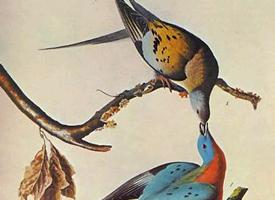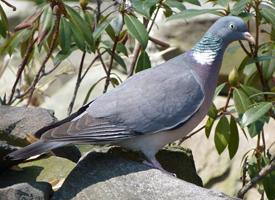
Poids et mesures
| Longueur | 41 cm |
|---|---|
| Poids | de 450 à 500 g |
| Envergure des ailes | de 75 à 80 cm |
Description de l'animal
The Common Wood Pigeon (Columba palumbus) is a large, robust bird that belongs to the family Columbidae, which includes doves and pigeons. It is widespread across Europe, North Africa, and western Asia, inhabiting a variety of environments from woodlands and forests to parks and gardens in urban areas. This species has adapted well to human-altered landscapes, making it a familiar sight for many.Characteristically, the Common Wood Pigeon measures between 38 to 44.5 cm in length and weighs approximately 300 to 615 grams, making it the largest pigeon species in its native range. Its wingspan is impressive, ranging from 68 to 77 cm, which aids in its strong, direct flight. The plumage of this bird is predominantly grey with a pinkish breast, adding a touch of elegance to its appearance. The neck features a distinctive white patch, and during the breeding season, this white becomes more pronounced. The wings have a notable white band, which is highly visible during flight, and the tail is tipped with a broad white band, adding to its distinctive profile.
The Common Wood Pigeon has a varied diet that includes seeds, grains, buds, leaves, and occasionally, small invertebrates. This adaptability in feeding habits has contributed to its success across its range. It is particularly fond of agricultural crops, which sometimes leads to conflicts with farmers.
Breeding season for the Common Wood Pigeon varies depending on its location, but generally, it can breed throughout the year, with peaks in spring and summer. They are monogamous and are known to form strong pair bonds. Nests are relatively simple structures made of twigs and located in trees or on buildings. The female typically lays two white eggs, and both parents share the duties of incubating the eggs and feeding the altricial chicks, known as squabs. The squabs are fed a special secretion known as "pigeon milk," which is produced by both parents from the lining of their crop.
The call of the Common Wood Pigeon is a characteristic cooing, which is a familiar sound in its habitat. This cooing plays a crucial role in the bird's social and breeding behaviors.
Despite facing threats from habitat loss, predation, and hunting in some areas, the Common Wood Pigeon has shown remarkable resilience. Its ability to exploit a wide range of food sources and habitats has enabled it to maintain stable population levels. Consequently, it is classified as Least Concern by the International Union for Conservation of Nature (IUCN), indicating that it is not currently at significant risk of extinction.
In conclusion, the Common Wood Pigeon is a symbol of adaptability and resilience. Its widespread presence across diverse habitats, coupled with its distinctive appearance and behavior, makes it an integral part of the avian biodiversity in its range. As it continues to navigate the challenges of a changing world, the Common Wood Pigeon remains a testament to the enduring spirit of nature's inhabitants.
Animaux similaires
Nouvelles photos d'animaux
Top 10 des animaux
- Dolphin gull (Leucophaeus scoresbii)
- Diana monkey (Cercopithecus diana)
- Moustached guenon (Cercopithecus cephus)
- Galápagos tortoise (Geochelone nigra complex)
- Japanese macaque (Macaca fuscata)
- Russian tortoise (Testudo horsfieldii)
- Stone loach (Barbatula barbatula)
- Greek tortoise (Testudo graeca)
- Common flying dragon (Draco volans)
- Vendace (Coregonus albula)


